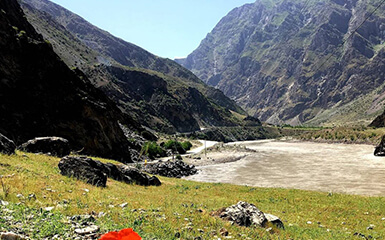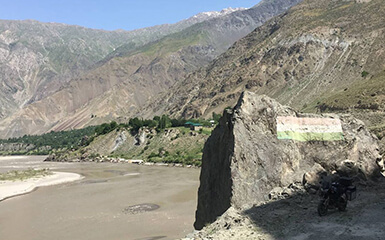Kok Gumbaz
Ajina Teppa
Ancient Panjakent
Anzob Tunnel
Beshkent Qala
Childukhtaron
Khazrati Shokh
Mug Teppa
Gharm Chashma
Hisor Historical
Haji Yaqub mosque
Hazrati-Bobo complex
Lake Iskanderkul
Kalai-Khumb
Karatag
Karon
Khishtin caravanserai
Khorog
Khulbuk
Lake Karakul
Abdullatif Sultan
Madrasai Kuhna
Abu Abdullah Rudaki
Khoja Mashhad
Khudoyor Valami
Makhmudi Azam
Mir Sayyid Ali Hamadani
Muhammed Bashoro
Sheikh Muslihiddin
Nurek Mountain Lake
Pamir
Sarazm
Sari-Khosor
Seven Lakes
Shirkent
Chiluchorchashma
Takht-i Sangin
Kalai-Khumb

Kalai-Khumb is a small urban-type settlement located along the banks of the Pyanj River and one of the first populated areas that arose along the Pamir Highway route. From the Persian language, the name of this town is translated as "Fortress on Khumb"; this is due to the fact that at first in the 15th century a military fortress was founded here on the border of the Pamirs, which served as protection for the Timurid Empire from the eastern outskirts. Over time, the outpost began to grow into small settlements, which later formed the city.
Later Kalai-Khumb was the capital of the independent Darvaz Khanate, whose history ended at the end of the 19th century. Then, for a short time, the lands of Kalai-Khumb were part of the Bukhara Khanate, and with the beginning of the era of the Soviet Union, the city became the centre of the Gorno-Badakhshan region of the Tajik SSR. Today Kalai-Khumba is the administrative centre of the Darvaz region in the Gorno-Badakhshan Autonomous Region.
During archaeological excavations on the outskirts of Kalai-Khumb, the remains of ancient settlements and fortifications were found. Including the fortress on Khumb left behind only ruins. However, ancient stone buildings have survived to this day. The landscapes of Kalai-Khumb are very picturesque; there are many places where nature remains in its original form. Pompous mountains, green areas and colourful sunsets and sunrises can provide an unforgettable experience for any traveller.
The city of Kalai-Khumb is located directly on the border with Afghanistan. Not far from the city there is one of three bridges over which you can cross the Panj River. Previously, an oriental bazaar was organized near the bridge on Sundays, in particular, this was done for merchants who arrived from Afghanistan, but today such bazaars are not organized in Kalai-Khumb.
The cosy city of 1,600 inhabitants has both guesthouses and luxury hotels. It is worth noting that Kalai-Khumb has its own small airport, from which flights across Tajikistan regularly depart. The climate here is comfortable and there are no sudden temperature changes from sweltering heat to cold, despite the fact that the Pamir region is rather harsh. However, precipitation here in winter is many times more than in summer.
Kalai-Khumb is the first district in a series of small towns located on the Pamir Road, where tourists and guests of the city make their first stop when they travel along the highway from the capital Dushanbe.

